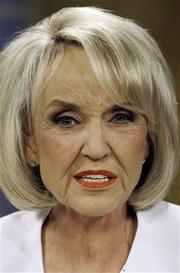PHOENIX Arizona Gov. Jan Brewer said Thursday she’s angry over comments by Secretary of State Hillary Rodham Clinton that the Obama administration will sue the state over its new immigration law.In a June 8 media interview in Ecuador that began circulating Thursday in the U.S., Clinton said President Barack Obama thinks the federal government should determine immigration policy and that the Justice Department “will be bringing a lawsuit against the act.”Justice spokeswoman Tracy Schmaler on Thursday declined to say whether the department would sue and that “the department continues to review the law.”
The department has been looking at the law for weeks for possible civil rights violations, with an eye toward a possible court challenge.It’s unclear why Clinton made the comment since it’s not her area. She couldn’t be reached Thursday for comment.State Department spokesman P.J. Crowley said Obama and Clinton have both made it clear that the administration opposes the law.
 “I will defer to the Justice Department on the legal steps that are available and where they stand on the review of the law,” Crowley said. “The secretary believes that comprehensive immigration reform is a better course of action.”Brewer, a Republican, said in a statement that “this is no way to treat the people of Arizona.”
“I will defer to the Justice Department on the legal steps that are available and where they stand on the review of the law,” Crowley said. “The secretary believes that comprehensive immigration reform is a better course of action.”Brewer, a Republican, said in a statement that “this is no way to treat the people of Arizona.”
“To learn of this lawsuit through an Ecuadorean interview with the secretary of state is just outrageous,” she said. “If our own government intends to sue our state to prevent illegal immigration enforcement, the least it can do is inform us before it informs the citizens of another nation.”Brewer spokesman Paul Senseman said the governor was “outraged” and that Clinton’s comments make it appear that the Justice Department has decided to file suit.
“But she’s confident that in the end, the state of Arizona, the citizens, will prevail,” he said.On April 23, Brewer signed what is considered the toughest legislation in the nation targeting illegal immigrants. It is set to go into effect July 29 pending multiple legal challenges and the Justice Department’s review.
The law requires police investigating another incident or crime to ask people about their immigration status if there’s a “reasonable suspicion” they’re in the country illegally. It also makes being in Arizona illegally a misdemeanor, and it prohibits seeking day-labor work along the state’s streets.The law’s stated intention is to drive illegal immigrants out of Arizona and discourage them from coming in the first place. It has outraged civil rights groups, drawn criticism from Obama and led to marches and protests organized by people on both sides of the issue.
The law’s backers say Congress isn’t doing anything meaningful about illegal immigration, so it’s the state’s duty to address the issue. Critics say it will lead to racial profiling and discrimination against Hispanics, and damage ties between police and minority communities.Brewer met with Obama in the Oval Office about the law on June 3, telling him: “We want our border secured.” Obama reiterated his objections to the law. Neither side appeared to give ground although both talked about seeking a bipartisan solution.
Other Arizona politicians, political candidates and activist groups were quick to weigh in on Clinton’s remarks. U.S. Senate candidate J.D. Hayworth, who is challenging Sen. John McCain, called them appalling; attorney general candidates Tom Horne and Andrew Thomas also denounced them.Joanne Lin, legislative counsel for the American Civil Liberties Union, urged the administration to take swift action against the law.(AP)

